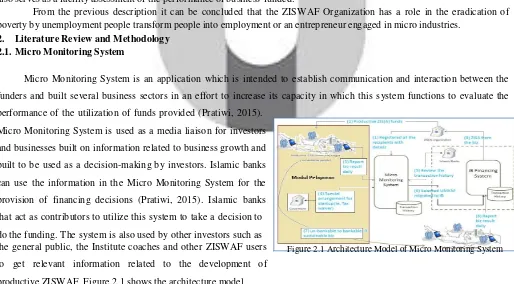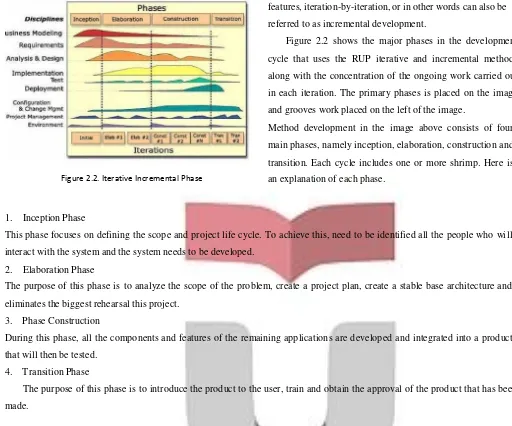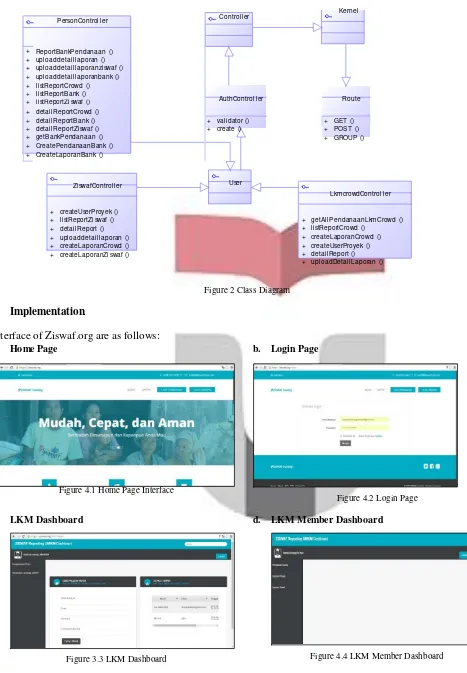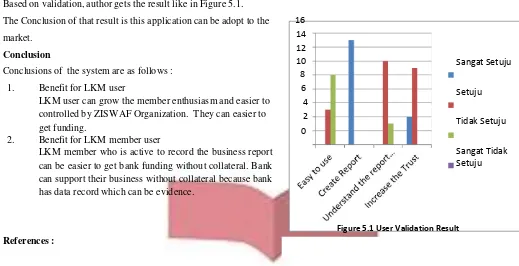DEVELOPING REPORTING MODULE IN MICRO MONITORING SYSTEM FOR SMALL
MEDIUM ENTERPRISE USING ITERATIVE INCREMENTAL METHOD AND LARAVEL
FRAMEWORK
Nana Ramadhewi1, Murahartawaty.,S.T,MT2, Nur Ichsan Utama.,S.T, M.T 3
,
Dr. Ari Pratiwi.,S.T, M.M41,2,3
S1 Information System, School of Engineering, Universitas Telkom
4
IBM
[email protected]
1[email protected] 2[email protected] 3 [email protected] 4Abstrak
Krisis moneter yang menimpa Indonesia pada tahun 1997 membuktikan Usaha Mikro Kecil dan Menengah (UMKM) mampu bertahan dan membantu perekonomian . Saat ini UMKM Indonesia berkisar 99,95% dari total usaha dan merupakan penyerap tenaga kerja tertinggi di Indonesia sendiri. Mengacu pada hasil survey oleh Kenan Institute Asia, UMKM Indonesia memiliki masalah paling banyak dibandingkan Negara ASEAN lainnya.Salah satu factor penyebab masalahnya adalah UMKM di Indonesia banyak yang tidak mengerti pembuatan laporan bisnis untuk meningkatkan kepercayaan pemodal usaha. Pada tahun 2015, ASEAN memulai ASEAN Economic Community (AEC). Ini adalah tantangan sekaligus kesempatan baru untuk UMKM Indonesia. Penelitian ini menyajikan sistem yang terintegrasi untuk menjawab permasalahan UMKM Indonesia. Dua fitur yang terintegrasi adalah business monitoring dan crowdfunding. Fitur-fitur tersebut saling terintegrasi satu sama lain. Module Reporting yang ada di penelitian ini adalah bagian dari business monitoring yang berfungsi mengelola laporan. Laporan tersebut menjadi faktor peningkatan kepercayaan masyarakat terhadap distribusi dana Zakat, Infaq, Sodaqoh, Wakaf (ZISWAF) oleh lembaga ziswaf, dan memudahkan penerima dana ZISWAF untuk mengajukan pinjaman ke bank tanpa jaminan serta mengurangi angka pengangguran
Kata kunci : UMKM Indonesia, AEC, pengangguran, capital, business monitoring and crowdfunding
Abstract
During the monetary crisis that hit Indonesia in 1997, Small Medium Enterprises (SMEs) has successfully survived and
greased the economic. Nowadays, Indonesia’s SMEs nearly 99,95% of total enterprises and the highest enterprise
which engage employee. That means SMEs can decrease the number of unemployed people in Indonesia. Referring to a
survey result by Kenan Institute Asia, Indonesia’s SMEs has the most problems compared the other ASEAN countries.
Restricted access to obtaining stable capital is the most Indonesia’s SMEs problems. The factor of that problem is a lot
of Indonesia’s SMEs does not understand how to make a business report because of lack of knowledge. In 2015,
ASEAN start to open ASEAN Economic Community (AEC). It is the new challenge and opportunity for Indonesia’s
SMEs. This research offers an integrated system to answer the problem of Indonesia’s SMEs. Two features in this system
contain of business monitoring and crowdfunding. Those features are integrated into each other. Reporting Module in this research is a part of business monitoring system. The report will be a factor to grow the trust of Zakat, Infaq, Sodaqoh, Wakaf (ZISWAF) organization to distribute money from people, help ZISWAF receiver to get funding from bank without collateral, and minimize unemployment people rate.
Keywords: Indonesia’s SMEs, AEC, unemployed, capital, business monitoring and crowdfunding integrated system
1. Preliminary
Indonesia is a developing country. One of the difficult problems is to handle poverty in developing country. Based on
the data obtained from the Central Statistics Agency (BPS), Poverty Depth Index (P1) and Poverty Severity Index (P2) tends to
Indonesia reached 28,59 million votes (11.22 percent), increased by 0.86 million people compared to the condition that at 27
September 2014 , 73 million people (10.96 percent).
The main cause of poverty in Indonesia is unemployment people. According to Saunders (2002), the relationship
between unemployment and poverty as follows: There are people who are poor and do not work (1), the working poor, who are
classified workers with low income (2), the person who, though not working but not poor (3), and those who are not poor
because of work (4). Bureau of Statistics data showed that the decline in unemployment with the number of unemployed
amounted to 5.81 percent in February 2015 in comparison with August 2014 amounted to 5.94 percent, and increased
compared to February 2014 amounted to 5.70 percent.
The problem of poverty in Indonesia is largely due to the number of unemployed. Based on that fact, micro, small and medium enterprises (SMEs) could be a solution. There are at least three reasons underlying the developing countries in recent stir SME sector (Berry, et al, 2001). The first reason is because the performance of SMEs / SMEs tends to be better in terms of generating productive employment. Secondly, as part of dynamics, SMBs / SMEs often achieves increased productivity through investment and technological change. The third, because of believe that SMBs / SMEs have advantages in terms of flexibility than large businesses. SMEs as one of the poverty rate deduction is also evidenced by the number of business units contributed to the 998% of the total business in Indonesia, absorbing 99.44%.
ZISWAF organization as the distributor and capital creator fund micro enterprises that work in cooperation with Islamic banks (Islamic banking) gives the beneficiary obligation to report on some indicators of their business development on a daily basis or within a specific time period. The report will be deposited into a system called Micro Monitoring System, so the development of micro-businesses (micro enterprise) can be monitored directly by Islamic banks as potential investors through Micro Monitoring System as a Decision Support System. Financial reporting modules contained in Micro Monitoring System, enables role of SMEs assisted ZISWAF institution builder. After efforts to get investment, further efforts will still be monitored by the bank through the financial statements that are stored in the Micro Monitoring System (Pratiwi, 2015).
According Pratama (2015), Micro Monitoring System is a system that has functions to establish communication, interaction and transparency between funders and some business sectors built as an effort to increase its capacity. This syst em also serves as a facility assessment of the performance of business-funded.
From the previous description it can be concluded that the ZISWAF Organization has a role in the eradication of poverty by unemployment people transform people into employment or an entrepreneur engaged in micro industries.
2. Literature Review and Methodology 2.1. Micro Monitoring System
Micro Monitoring System is an application which is intended to establish communication and interaction between the
funders and built several business sectors in an effort to increase its capacity in which this system functions to evaluate the
performance of the utilization of funds provided (Pratiwi, 2015).
Micro Monitoring System is used as a media liaison for investors
and businesses built on information related to business growth and
built to be used as a decision-making by investors. Islamic banks
can use the information in the Micro Monitoring System for the
provision of financing decisions (Pratiwi, 2015). Islamic banks
that act as contributors to utilize this system to take a decision to
do the funding. The system is also used by other investors such as the general public, the Institute coaches and other ZISWAF users
to get relevant information related to the development of
productive ZISWAF. Figure 2.1 shows the architecture model.
2.2. Iterative & Incremental Development
Iterative method is an approach to create a software life cycle consists of several mutually sequential iterations. Each iter ation
consists of a small project drawn up by activities such as requirements analysis, design, programming and testing. In this
development, usually some systems to grow with new
features, iteration-by-iteration, or in other words can also be
referred to as incremental development.
Figure 2.2 shows the major phases in the development
cycle that uses the RUP iterative and incremental methods
along with the concentration of the ongoing work carried out
in each iteration. The primary phases is placed on the image
and grooves work placed on the left of the image.
Method development in the image above consists of four
main phases, namely inception, elaboration, construction and
transition. Each cycle includes one or more shrimp. Here is
Figure 2.2. Iterative Incremental Phase an explanation of each phase.
1. Inception Phase
This phase focuses on defining the scope and project life cycle. To achieve this, need to be identified all the people who will
interact with the system and the system needs to be developed.
2. Elaboration Phase
The purpose of this phase is to analyze the scope of the problem, create a project plan, create a stable base architecture and
eliminates the biggest rehearsal this project.
3. Phase Construction
During this phase, all the components and features of the remaining applications are developed and integrated into a product
that will then be tested.
4. Transition Phase
The purpose of this phase is to introduce the product to the user, train and obtain the approval of the product that has been
made.
2.3. Laravel Framework
Laravel is a PHP framework released under the MIT license, was built with the concept of MVC (model view controller).
MVC is a software approach that separates application logic from presentation. MVC separates the application based on the
components of applications, such as data manipulation, controller and user interface.
2.4. Conceptual Model
The conceptual model is the concept of thought that helps researchers to formulate solutions and assist in the formulation of
the solution of the existing problems. Reporting modules may be linked to other modules in the development of Micro
Monitoring System. Figure 2.3 shows the Module Integration of this research.
With the integration of data modules as in the picture above, the conceptual model created with tuck some input from the othe r
Zi swaf Reci pi ent Data
Figure 2.3 Module Integration Figure 2.4 Conceptual Model
3. Pembahasan
3.1. Design System
3.1.1. Use Case Diagram
Use Case Diagram created based on business process.
Use Case of Reporti ng M odul e
M anage M em ber
LKM
M anage Zi swaf <<Incl ude>>
Report Get the Report Zi swaf Organi zati on
Report <<Incl ude>> Get the Report.
Figure 1 Use Case Diagram of Reporting System
3.1.2. Class Diagram
PersonControl l er Control l er
Kernel
+ ReportBankPendanaan ()
AuthControl l er Route + upl oaddetai l l aporan ()
+ upl oaddetai l l aporanzi swaf () + upl oaddetai l l aporanbank () + l i stReportCrowd () + l i stReportBank () + l i stReportZi swaf () + detai l ReportCrowd ()
+ detai l ReportBank () + val i dator () + GET ()
+ + +
detai l ReportZi swaf () getBankPendanaan () CreatePendanaanBank ()
+ create () +
+ POST () GROUP ()
+ CreateLaporanBank ()
Zi swafControl l er User
LkmcrowdControl l er
+ createUserProyek () + l i stReportZi swaf () + detai l Report () + upl oaddetai l l aporan () + createLaporanCrowd () + createLaporanZi swaf ()
+ getAl l PendanaanLkmCrowd () + l i stReportCrowd ()
+ createLaporanCrowd () + createUserProyek () + detai l Report () + upl oadDetai l Laporan ()
Figure 2 Class Diagram
4. Implementation
Interface of Ziswaf.org are as follows:
a. Home Page b. Login Page
Figure 4.1 Home Page Interface
Figure 4.2 Login Page
c. LKM Dashboard
Figure 3.3 LKM Dashboard
d. LKM Member Dashboard
5. User Validation
Based on validation, author gets the result like in Figure 5.1.
The Conclusion of that result is this application can be adopt to the 16
market. 14
12 6. Conclusion 10 Conclusions of the system are as follows : 8
1. Benefit for LKM user 6
LKM user can grow the member enthusiasm and easier to 4
controlled by ZISWAF Organization. They can easier to 2
get funding. 0 2. Benefit for LKM member user
LKM member who is active to record the business report can be easier to get bank funding without collateral. Bank can support their business without collateral because bank has data record which can be evidence.
References :
Sangat Setuju
Setuju
Tidak Setuju
Sangat Tidak Setuju
Figure 5.1 User Validation Result
Bank, W. (2010). Investing Across Borders, The World Bank Group, Washington, D.C. .
Berry, A., & Rodriguez, E. (2001). H. Sandee,”Small and Medium Enterprise Dynamics in Indonesia”, Bulletin of Indonesian Economic Studies, Vol. 37 No. 2.
Jumlah dan Persentase Penduduk Miskin, Garis Kemiskinan, Indeks Kedalaman Kemiskinan (P1), dan Indeks Keparahan Kemiskinan (P2). (2013-2014). Retrieved from http://www.bps.go.id/linkTabelStatis/view/id/1488




